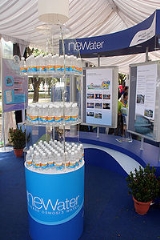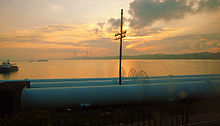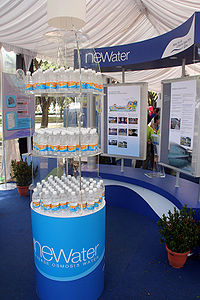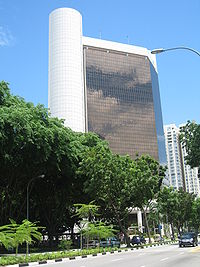
Water resources of Singapore
Encyclopedia
| Singapore Singapore Singapore , officially the Republic of Singapore, is a Southeast Asian city-state off the southern tip of the Malay Peninsula, north of the equator. An island country made up of 63 islands, it is separated from Malaysia by the Straits of Johor to its north and from Indonesia's Riau Islands by the... : Water and Sanitation |
||
|---|---|---|
 |
||
| Data | ||
| Access to an improved water source Improved water source According to the Joint Monitoring Program for Water Supply and Sanitation by the World Health Organization and UNICEF the following are considered as "improved" water sources:* household connections* public standpipes* boreholes* protected dug wells... |
100% (2008) | |
| Access to improved sanitation Improved sanitation According to the Joint Monitoring Programme for Water Supply and Sanitation by the World Health Organization and UNICEF the following are considered as "improved" sanitation:* connection to a public sewer* connection to a septic system* pour-flush latrine... |
100% (2008) | |
| Continuity of supply (%) | 100 | |
| Average urban water use (l/c/d) | 155 (2009) | |
| Average urban water tariff (US$/m3) | US$1.29 (S$1.62, 2010, for a consumption of 20m3 per month) | |
| Share of household metering | 100% | |
| Annual investment in WSS | ||
| Share of self-financing by utilities | 100% | |
| Share of tax-financing | None | |
| Share of external financing | Private commercial financing through BOTs | |
| Institutions | ||
| Decentralization | No | |
| National water and sanitation company | Yes, the Public Utilities Board Public Utilities Board The Public Utilities Board is a statutory board of the Ministry of the Environment and Water Resources under the Government of Singapore.... (PUB) |
|
| Water and sanitation regulator | None | |
| Responsibility for policy setting | Ministry of the Environment and Water Resources | |
| Sector law | ||
| Number of urban service providers | 1 | |
Water supply and sanitation in Singapore is characterized by a number of achievements in the challenging environment of a densely populated island. Access to water is universal, affordable, efficient and of high quality. Innovative integrated water management approaches such as the reuse of reclaimed water
Reclaimed water
Reclaimed water or recycled water, is former wastewater that is treated to remove solids and certain impurities, and used in sustainable landscaping irrigation or to recharge groundwater aquifers...
, the establishment of protected areas in urban rainwater catchments and the use of estuaries as freshwater reservoirs have been introduced along with seawater desalination
Desalination
Desalination, desalinization, or desalinisation refers to any of several processes that remove some amount of salt and other minerals from saline water...
in order to reduce the country's dependence on imported water. In 2007 Singapore's water and sanitation utility, the Public Utilities Board
Public Utilities Board
The Public Utilities Board is a statutory board of the Ministry of the Environment and Water Resources under the Government of Singapore....
, received the Stockholm Industry Water Award for its holistic approach to water resources management.
History
Singapore's first reservoir was the MacRitchie reservoir, which was built by the British in 1867. Subsequently, as Singapore developed into a modern city, more sources of water were needed to sustain the city’s growth. Thus two local reservoirs were added to the rapidly modernising colonial city. After independence in 1965, the Public Utilities Board took over the control of basic supplies including water. From then on, there have been many developments and improvements to increase the water supply for Singapore. The 1960s and 1970s saw great development for Singapore. In order to maintain that, many big water projects were embarked upon to increase the water supply. Examples of these projects included the Kranji-Pandan Scheme, the Upper Pierce Project and the Western Catchment Water Scheme.In 2001 the Public Utilities Board
Public Utilities Board
The Public Utilities Board is a statutory board of the Ministry of the Environment and Water Resources under the Government of Singapore....
, which had previously been in charge of water supply only, was given the responsibility for sanitation as well which had previously been directly provided by the Ministry of Environment. The change facilitated the implementation of an integrated water management approach. In 2002 Singapore inaugurated its first reclaimed water plant after a monitoring period of two years to ensure safe water quality. In 2005 it opened its first desalination plant. By the time the long-term water supply agreement with Malaysia expires in 2061, Singapore wants to be self-sufficient in terms of water supply, with reclaimed water meeting 40% and desalination 30% of its needs in addition to the 20% supplied by internal catchments.
Water sources
The water resources of SingaporeSingapore
Singapore , officially the Republic of Singapore, is a Southeast Asian city-state off the southern tip of the Malay Peninsula, north of the equator. An island country made up of 63 islands, it is separated from Malaysia by the Straits of Johor to its north and from Indonesia's Riau Islands by the...
are especially precious given the small amount of land and territory in Singapore's geography
Geography and climate of Singapore
Singapore is a small, heavily urbanised, island city-state in Southeast Asia, located at the southern tip of the Malayan Peninsula between Malaysia and Indonesia. Singapore has a total land area of 778 km² and 193 km of coastline...
while having a large urban population
Demographics of Singapore
This article is about the demographic features of the population of Singapore, including population density, ethnicity, education level, health of the populace, economic status, religious affiliations and other aspects of the population....
in the city-state
City-state
A city-state is an independent or autonomous entity whose territory consists of a city which is not administered as a part of another local government.-Historical city-states:...
. Without natural freshwater
Freshwater
Fresh water is naturally occurring water on the Earth's surface in ice sheets, ice caps, glaciers, bogs, ponds, lakes, rivers and streams, and underground as groundwater in aquifers and underground streams. Fresh water is generally characterized by having low concentrations of dissolved salts and...
lake
Lake
A lake is a body of relatively still fresh or salt water of considerable size, localized in a basin, that is surrounded by land. Lakes are inland and not part of the ocean and therefore are distinct from lagoons, and are larger and deeper than ponds. Lakes can be contrasted with rivers or streams,...
s, Singapore relies on four water sources:
- rainfall, collected in reservoirs or water catchment areas (about 20% of supply in 2010),
- Imported water from Malaysia (about 40% of supply),
- Reclaimed waterReclaimed waterReclaimed water or recycled water, is former wastewater that is treated to remove solids and certain impurities, and used in sustainable landscaping irrigation or to recharge groundwater aquifers...
(producing NEWaterNEWaterNEWater is the brand name given to reclaimed water produced by Singapore's Public Utilities Board. More specifically, it is treated wastewater that has been purified using dual-membrane and ultraviolet technologies, in addition to conventional water treatment processes...
) (30% of supply), and - Seawater desalinationDesalinationDesalination, desalinization, or desalinisation refers to any of several processes that remove some amount of salt and other minerals from saline water...
(10% of supply).
This "four tap" strategy aims to reduce reliance on supply from Malaysia by increasing the volume supplied from the three other sources, or "national taps".
Supply provided by water catchment areas
Two thirds of the country's surface area are classified as partly protected catchment areas with certain restrictions on land use, so that the rainwater can be collected and used as drinking water.As of 2010, the water supply system included 19 raw water reservoirs, 9 treatment works and 17 service reservoirs for treated water. The largest reservoir, the Marina Bay reservoir inaugurated in 2008, is in the estuary of a river that has been closed off by a barrage to keep the seawater out. Two similar barrages are due to be completed in 2011 and will form the Punggol Reservoir and the Serangoon Reservoir.
Imported water supply

Reclaimed water

Brand
The American Marketing Association defines a brand as a "Name, term, design, symbol, or any other feature that identifies one seller's good or service as distinct from those of other sellers."...
given to reclaimed water
Reclaimed water
Reclaimed water or recycled water, is former wastewater that is treated to remove solids and certain impurities, and used in sustainable landscaping irrigation or to recharge groundwater aquifers...
produced by Singapore
Singapore
Singapore , officially the Republic of Singapore, is a Southeast Asian city-state off the southern tip of the Malay Peninsula, north of the equator. An island country made up of 63 islands, it is separated from Malaysia by the Straits of Johor to its north and from Indonesia's Riau Islands by the...
's public utilities. More specifically, it is treated wastewater
Wastewater
Wastewater is any water that has been adversely affected in quality by anthropogenic influence. It comprises liquid waste discharged by domestic residences, commercial properties, industry, and/or agriculture and can encompass a wide range of potential contaminants and concentrations...
(sewage) that has been purified using dual-membrane (via microfiltration
Microfiltration
Microfiltration is a membrane technical filtration process which removes contaminants from a fluid by passage through a microporous membrane. A typical microfiltration membrane pore size range is 0.1 to 10 micrometres...
and reverse osmosis
Reverse osmosis
Reverse osmosis is a membrane technical filtration method that removes many types of large molecules and ions from solutions by applying pressure to the solution when it is on one side of a selective membrane. The result is that the solute is retained on the pressurized side of the membrane and...
) and ultraviolet technologies, in addition to conventional water treatment processes.
As of 2008, there are five NEWater factories, located at the Bedok
Bedok
Bedok is a neighbourhood in the eastern part of Singapore. Bedok New Town is the fifth Housing and Development Board new town; its development started in April 1973 and continued over some 15 years....
, Kranji
Kranji
Kranji is a suburb in northwestern Singapore, located about from the city centre.-Etymology:Kranji is named after a local tree, the kranji or keranji . Its abundance has rapidly dwindled since the first half of the nineteenth century.-History:The first Singapore-Kranji railway from Tank Road to...
, and Seletar
Seletar
Seletar is an area of Singapore within its North-East Region. Seletar commonly refers to the areas south of Yishun and west of Sungei Punggol, covering Yio Chu Kang near Jalan Kayu , the Lower Seletar Reservoir and part of Upper Thomson .The Seletar Planning Area, an urban planning zone under the...
, Ulu Pandan and Changi
Changi
Changi is an area at the eastern end of Singapore. It is now the site of Singapore Changi Airport/Changi Air Base, Changi Naval Base and is also home to Changi Prison, site of the former Japanese Prisoner of War Camp during World War II which held Allied prisoners captured in Singapore and Malaysia...
Water Reclamation Plants, producing 50 million impgals (227,304.5 m³) per day. Some of the NEWater is used at wafer fabrication
Wafer fabrication
Wafer fabrication is a procedure composed of many repeated sequential processes to produce complete electrical or photonic circuits. Examples include production of radio frequency amplifiers, LEDs, optical computer components, and CPUs for computers...
plants and other non-potable applications in industries. The rest is fed into nearby reservoirs. NEWater is currently able to meet 30% of Singapore's water requirements.
The Deep Tunnel Sewerage System (DTSS), a 48-km long deep tunnel sewer that runs 20 to 55 metres below ground, channels used water to a centralised water reclamation plant for treatment. The treated used water will then be discharged into the sea or further purified into NEWater. The deep tunnel works entirely by gravity, eliminating the need for pumping stations, and thus the risks of used water overflows. At one-third the size of conventional plants, the Changi Water Reclamation Plant is designed to be compact. Centralisation of used water treatment at Changi also allows for economies of scale. Until DTSS will be completed, wastewater is collected through a sewer system that includes 139 pumping stations that pump water to six wastewater treatment plants. These pumping stations and plants will be decommissioned when the DTSS will become operational.
Desalination
On 13 September 2005, the country opened its first desalinationDesalination
Desalination, desalinization, or desalinisation refers to any of several processes that remove some amount of salt and other minerals from saline water...
plant by SingSpring. SingSpring is majority-owned by CitySpring Infrastructure Trust
CitySpring Infrastructure Trust
CitySpring Infrastructure Trust owns four utility assets, namely City Gas and SingSpring in Singapore, and Basslink Interconnector and Basslink Telecoms in Australia....
(CitySpring). The plant, located at Tuas
Tuas
Tuas is largely an industrial zone located in the western part of Singapore. The Tuas Planning Area is located within the West Region, and is bounded by Tengeh Reservoir to the north, Strait of Johor to the west, Straits of Singapore to the south, and the Pan Island Expressway to the east.It is...
, can produce 30 million impgals (136,382.7 m³) of water each day. Worth S$200 million, it is one of the biggest in the world and meets 10 percent of the country's water needs. The plant also produces bottled water called the Desal H2O. A bid for a second desalination plant with a capacity of 318,500 m³ per day, also located at Tuas, was launched in June 2010. The government has identified five coastal sites for future plants, with the objective of bringing the installed capacity to one million m³ per day by 2060.
Some observers have suggested that Singapore could become the world's water hub for water recycling and desalination technology and could export this technology to the world including China
China
Chinese civilization may refer to:* China for more general discussion of the country.* Chinese culture* Greater China, the transnational community of ethnic Chinese.* History of China* Sinosphere, the area historically affected by Chinese culture...
. Dr Masaru Kurihara, director of the International Desalination Association
International Desalination Association
International Desalination Association is a global organization dedicated to desalination, desalination technology and water reuse. With more than 2,000 members from around 58 countries, IDA is the hub of expertise, news and information, and professional development for the worldwide desalination...
, said that with the new technology in water reclamation, waste water would become the most important sustainable water resource in the future.
Water use, conservation and efficiency
There have also been campaigns to urge people to conserve water, reducing consumption from 165 litres per person per day in 2003 to 155 litres in 2009. The target is to lower it to 140 litres by 2030. The level of water losses - more precisely defined as non-revenue waterNon-revenue water
Non revenue water is water that has been produced and is “lost” before it reaches the customer. Losses can be real losses or apparent losses . High levels of NRW are detrimental to the financial viability of water utilities, as well to the quality of water itself...
- is one of the lowest in the world at only 5%.
Responsibility for water supply and sanitation

Public Utilities Board
The Public Utilities Board is a statutory board of the Ministry of the Environment and Water Resources under the Government of Singapore....
, a statutory board
Statutory boards of the Singapore Government
The statutory boards of the Singapore Government are organisations that have been given autonomy to perform an operational function. They usually report to one specific ministry.*Accounting and Corporate Regulatory Authority...
under the Ministry, is in charge of service provision.
Financial aspects
Water tariffs in Singapore are set at a level allowing cost recovery, including capital costs. In 2005 PUB issued for the first time a bond, raising S$400 million, to finance part of its investment program. Water tariffs also provide incentives for water conservation. They include a water conservation tax whose proceeds go directly to the government. The tax is set at 30%, but a 45% tax level applies to domestic consumption above 40m3 per month and connection. As of 2010 the domestic water tariff without taxes was set at S$1.17/m3 for consumption below 40m3 per month and connection, and at S$1.40/m3 for higher consumption. The sewerage tariff (called "waterborne fee") is S$0.30/m3 for domestic users independent of consumption. The water and sewerage tariff including the conservation tax (30%) and general service tax (7%) thus is about S$1.62, to which a fixed tariff of S$3 per chargeable fitting and per month has to be added. A household consuming 20m3 per month and three chargeable fittings thus would face a bill of S$41.54 per month or S$2.08 per m3 (US$1.62/m3). This residential tariff is much lower than tariffs in some European countries such as Germany. Industrial water tariffs are set even lower at S$0.43/m3. Water tariffs were raised substantially in the late 1990s, so that the average monthly domestic bill including taxes increased from S$13 in 1996 to S$30 in 2000.External links
Further reading
- Ministry of Foreign Affairs of Singapore:Frequently asked questions:Water trade and Pedra Branca
- BBC News: Malaysia raises water stakes

